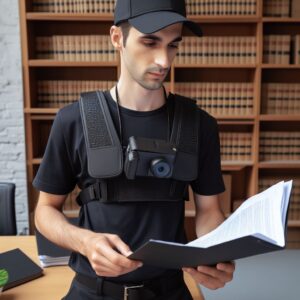Ensuring Safety and Accountability: The Role of Body-Worn Cameras for Process Servers

Empowering Process Servers: Enhancing Safety and Accountability.
In recent times, the safety of process servers has become a pressing concern. They often find themselves in challenging situations, facing unruly defendants who may threaten their safety. In response to these challenges, the introduction of body-worn cameras has sparked a debate within the legal service community. Do these cameras truly enhance the safety of process servers, and are they worth the investment? Let’s explore this topic and weigh the pros and cons of employing body-worn cameras in the world of legal process serving.
The Evolution of Body-Worn Cameras
The concept of body-worn cameras isn’t entirely new. These devices were first introduced in 2014 with the primary goal of promoting transparency and accountability in various situations, such as law enforcement’s response to emergency incidents. The idea was simple: when every interaction is recorded, it tends to encourage respectful and lawful behavior from all parties involved.
The Promise of Body-Worn Cameras
One of the most significant advantages of using body-worn cameras is the ability to capture real-time video evidence of the service of legal documents. This footage can serve as irrefutable proof that the defendant has indeed been served, ensuring that the legal process moves forward smoothly.
Moreover, these cameras can play a pivotal role in preserving the safety and well-being of process servers when confronted with hostile or unpredictable defendants. The mere presence of a recording device can often discourage aggressive behavior, keeping confrontations to a minimum.
Balancing Act: The Pros and Cons
While the advantages of body-worn cameras are apparent, it’s essential to acknowledge the potential drawbacks. One concern is the misuse of this technology. There have been instances where process servers have been accused of using body cameras to humiliate or intimidate defendants, leading to negative consequences.
Empowering Process Servers to Decide
Ultimately, the decision to utilize body-worn cameras should rest with the process server. They should have the autonomy to determine if equipping themselves with this technology is beneficial for their safety and the successful completion of their duties.
As an added layer of safety, some process servers may choose to employ these devices when serving particularly contentious individuals. It’s not about compromising trust or escalating conflicts but ensuring that process servers can fulfill their roles without fearing for their well-being.
In the ever-evolving landscape of legal process serving, the use of body-worn cameras remains a personal choice, one that strives to enhance safety and transparency while respecting the boundaries of professionalism. Ultimately, the goal is to provide process servers with the tools they need to perform their duties securely, professionally, and with integrity.
Updated: 10/14/2023

